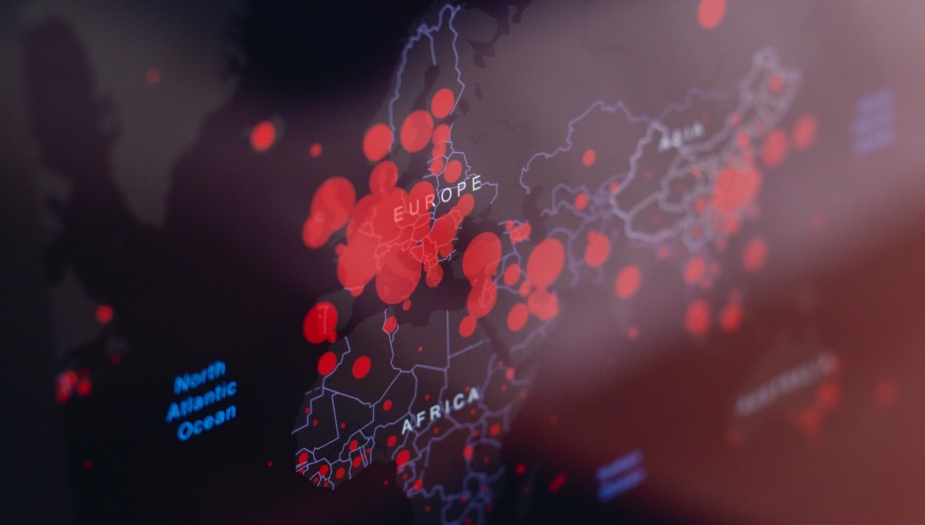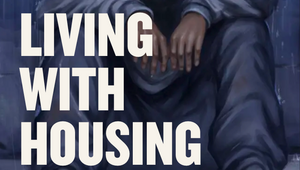
“There’s Lots That Data Has to Say About This Crisis”

The Covid-19 crisis will make data nerds of us all. Data, data, data - it dominates news, it confuses and it is everywhere. Epidemiological and statistical terms have become part of our everyday vocab. Governments deploy graphs and impressive looking numbers, sometimes to clarify, more often to obfuscate, and we the public have to decipher what’s really happening. Contact tracing apps have reignited debates on data privacy. And for businesses grappling to see beyond their own home offices and gut instincts, data has become the key to adaptable, nimble and timely decision-making.
LBB’s Laura Swinton caught up with the thoughtful and ever-curious Michael Horn, chief data officer at Huge, to dig into the big data stories of the past three months and to find out why the data-savvy businesses are the ones that are most adeptly navigating 2020.
LBB> What, for you, have been the interesting data stories to have emerged over the past couple of months, whether it’s industry or government stories?
Michael> There are two things that pop immediately. One is on the privacy side, with the contact tracing apps. What we’re really talking about is a lot of technologies that were used for ad targeting for a long time and then big companies got in trouble for it and pulled back. And now it’s like, ‘no, this is the time when we actually need geographic targeting and attribution’. But we have such scepticism for the technology as opposed to its legitimate use, we might end up undermining ourselves. That data story about privacy versus population security is playing out very differently in 2020 than had that conversation happened four years ago. We had a lot of those technologies four years ago but we now have a very different threshold of awareness, thanks to GDPR and CCPA, of what we believe it’s appropriate for governments and corporations to know about us. And so I think that is going to be a far-reaching, multi-year conversation.
And there’s this notion of the feedback loop of these models. You’re trying to predict how people’s behaviours will change but of course the model and the population’s reactions to the predictions of how many people will die or how many jobs will be lost will have a feedback loop, a sort of recursive effect on people’s behaviours. People who’ve been in the data science space are used to complexity but they’re not used to the sharing of that complexity acting back on itself. And the notion of the real time feedback – if we announce this, then people will start going outside and socialising again. There’s a really interesting separation of the math and the perception of the math, which is difficult for mathematicians and politicians alike.
LBB> That question of data privacy is certainly a hot topic in the UK at the moment as the government is in the pilot stages of a contact tracing app…
Michael> What’s also interesting is that even in Singapore people said, well, it’s an authoritarian government, they’ll be able to get on board but actually uptake in the countries that are furthest ahead haven’t got more than 30-40% penetration of these contact tracing apps. As the NHS rolls out this new strategy, can you voluntarily get enough people to enrol to actually reach that critical threshold? The privacy abuse questions are almost moot if you can’t actually get to a working solution!
Looking at the consumer psychology around data privacy, even without Covid-19, there are distinct segments that are more or less concerned. And part of this is the concern ‘about me’ or my perceived risk to other people. And I think what you find in compliance in wearing masks at least in the United States, there’s still a profound misunderstanding about what these steps are intended to do. How much of these steps are about protecting you as an individual as opposed to overall population healthcare characteristics. And you can do a lot with anonymised data with regards to population health but if you want to understand what your personal risk level is you need to get to a more addressable, detailed level of data that’s attributable to your movements - that’s really where the controversy is because some of the solutions that are being discussed and Google and Apple's approach is really more about being able to do one versus the other. Which are you prioritising? Population health or individual contact? And each methodology has distinct implications for those.
LBB> What sort of conversations have you had and work have you done with clients around using data to navigate the situation?
Michael> We went through a couple of distinct stages in terms of the types of questions we were getting and the type of work we were getting in on our side.
The first thing was that people were just paying much closer attention day-to-day to what was happening. We had an automotive retailer that initially didn’t see a drop off in service: ‘well, when’s it going to come?’
Initially we were just monitoring their data closely but then we found a toolkit that enabled us to move into a more predictive mindset – what are the leading indicators that will suggest how many months or weeks from now you will see that drop? We had questions from other retailers asking what will people's comfort levels be and when, so we had to field some research to understand people’s specific expectations of retailers, what steps they wanted them to take, what they were eager to get back to versus what were lower priorities.
Now we’ve moved onto this third stage which is actively helping brands plan for the reopening. Now we have information to work from, we need to help them prioritise what services they can and can’t deploy and also what they need to do for their employees versus what they need to do for their customers.
LBB> A lot of data’s power lies in its ability to help us spot trends and make predictions. Because there are still so many unknown factors around the shape of the disease – for example there’s a lot we don’t know about immunity – do you feel like in some ways it has tested the limitations of data?
Michael> I wouldn't say it's testing the ability of the data; there’s lots that data has to say about this crisis. I think what it has tested is the ability of organisations to decisively and effectively make decisions. What you end up seeing is that there are all kinds of reasons to say wait and see, but by definition, if you keep saying wait and see, you’re going to lose. The question is, can an organisation say, ‘we only know 60 or 70% of what we would like to know – is that enough to make a decision?’ ‘Should we hedge our bets and have two tracks of work, one that assumes a rapid reopening and one that assumes a longer term?’
I think the key thing for clients and brands that want to move forward is that you can’t afford to wait for perfect data. For people that are accustomed to healthy data-driven decision making cultures, that’s something they came to terms with and grappled with one to three years ago. They understood that it’s not about collecting everything and every last detail, it’s more about what is that critical threshold you need to reach?
Now other companies are under the gun and under these crazy timelines, and they are being forced to mature in a way that these leading companies did several years ago.
LBB> It seems to be that data is going to be crucial for businesses as they navigate the potentially prolonged and rather jerky exit too…
Michael> It’s funny, it already has been. What I find in my dealings with folks is that there is a lot of assumption around what they ‘knew’. Before Covid, everyone said, ‘I know what my customers need, I know how my customers behave’. I think what the pandemic has done is really jar people loose from thinking inertia and assumptions. The data was always out there and was always important, but now there’s an increasing willingness because the world is so uncertain, because the world is so disrupted.
People are more willing and understand the urgency of using more recent data from the past two weeks or past month, as opposed to the customer research they did five years ago that everyone still talks about. But to be clear, the companies that already have an advantage in this ecosystem are those that were already data driven before and therefore have been able to pivot much faster.
LBB> Some businesses, like supermarkets, have been impressively quick to tweak their supply chains in response to some wild consumer trends and data – who would have thought that ‘toilet paper panic’ and ‘baking sourdough’ would have been the things to cause sudden spikes in demand.
Michael> A lot what we saw in the supply chain in the US too is that problems got ironed out for a while, but it’s taken a couple of months for things to ripple through and create problems. There have been stories in the US of farms having to dump their produce or even kill off their herds, there’s a backlog at the slaughterhouses and meatpacking factories. I think you’re right with the superstores, the distribution end has been handled really well, the production end is now seeing these second and third order effects, which will continue for some time. It’s troubling to see where the government isn’t stepping in to help with demand, get food to food banks. Where there are collapses in the supply chain, they tend to cause domino effects. I think the last mile problem of delivery and wholesale to retail distribution has been handled pretty well in a lot of places - we haven’t seen the last of that. There will be shortages that last some time with certain types of products.
LBB> Another interesting data question is the way that the pandemic has highlighted issues around the way complex data is communicated to the public. What are your thoughts on that?
Michael> We’ve done research into data literacy applied in other domains, whether it’s financial literacy or health literacy and you see dramatic differences in the ability of different populations to apply data in workplace contexts, health contexts. Just as this was an important predictor in people’s employment prospects, now we’re seeing people's safety being put in the hands of others who don’t understand how to evaluate risk. What does anexponential curve look like? And what does it mean? Some of the conversations we were having earlier on in the pandemic introduced these concepts to people who just weren’t familiar with using them.
When you think about other population information challenges around climate change and the climate crisis, it is the battle between our emotions and our rational side. There’s a tension between the way that scientists tend to communicate (in the equations, in risks and probabilities and timelines) and the way politicians communicate, especially politicians with an agenda. It’s a reminder of just how difficult it is for people who are deeply scientific to communicate with the masses and this public health crisis will be remembered as a critical moment for scientists. If I want literally billions of people to change their behaviours, what do I need to say to affect that change? Even when you talk to data teams at brands or agencies, this is one of those classic things you deal with. How do you communicate with non-data people to affect action?
LBB> As non-data experts try to interpret data and graphs presented in news coverage and government announcements, what should we look out for?
Michael> There’s a whole classic playbook of how to manipulate people through data and you see all those tools happening now. A classic example is truncating scales – if you look at scales on a chart and you think, is it trying to show me a really steep drop off or did it just change the scale on the Y axis to make it look steeper than it is?
There are all sorts of ‘apples and oranges’ examples, where someone might be talking about the percentage of tests being taken versus the percent of positive results versus population immunity. We’ve seen in the US people combining all the different tests together – whether its tests for current caseloads or tests for immunity – just to have a bigger testing number and that’s actually meaningless. What you need to know is the number of active cases and, separately, whether a certain percentage of the population has achieved immunity. So look out for different types of data being summed because a bigger number looks better.
And I think the last thing is that there are natural patterns in the data. One thing I’ve heard is that at the weekends a lot of the state health agencies and testing sites shut down so you naturally expect to see case numbers decline at the weekends. And then on Monday you’ll see people with a particular political motivation or health motivation saying ‘it’s great! We’re looking at the data and there’s a downward trend!’. Yes! We knew there would be a downward trend – it’s the weekend!
LBB> What do you think we’re going to learn from all of this?
Michael> When history books are written about this, there will be a really interesting perspective on when this pandemic occurred. How different, had it occurred 10 years ago when a lot of the remote working opportunities just simply would not have been possible. Or had it occurred 10 years from now, when a lot of industrial automation and agricultural robotics would have picked up the slack and transported goods from place to place.
On the one hand we’re very fortunate that we can do as much via digital means as we can but we’re no where near as well prepared as we might have been 10 years from now. Maybe that will be the next pandemic! I say that not jokingly. This is a humbling moment for businesses as well as governments and I think there are lots of people doing some serious thinking once we are past the urgent phase of this.
What do we wish we had done a few years ago if we’d known it was coming?













